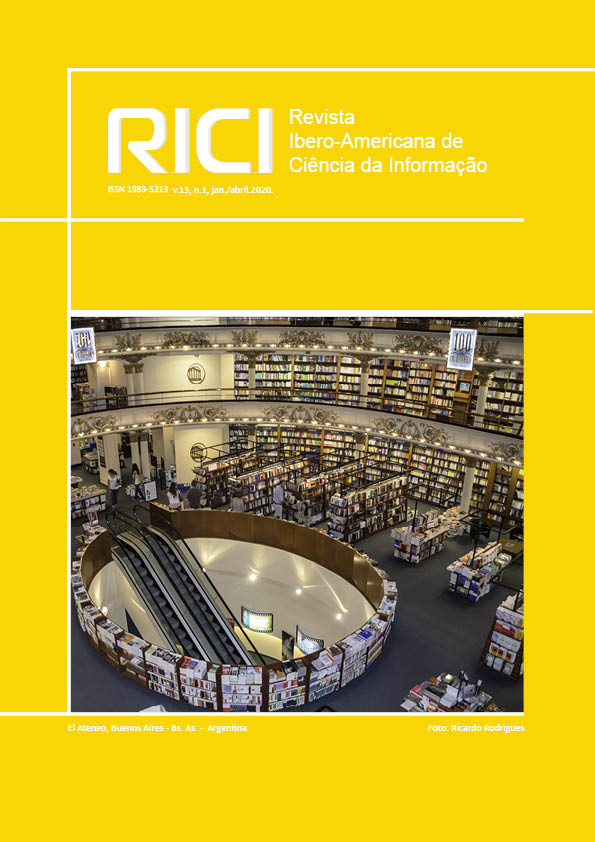The teaching of description in Archivology courses of Universidad de la República and Universidade Federal de Santa Catarina
DOI:
https://doi.org/10.26512/rici.v13.n1.2020.27067Keywords:
Archival Science., Documentary description, Uruguay, BrazilAbstract
This paper presents a comparison of the curricular unit of Documentary Description at the University of the Republic (UdelaR), Uruguay and of the discipline of Architectural Description at the Federal University of Santa Catarina (UFSC), Brazil. It is the result of a visit to UdelaR during the academic exchange period in the first semester of 2017. By comparing the teaching of the subject in the two universities, by analyzing the subject's plans in the first semesters of 2017 and 2019, it was observed that the teaching of the subject differs in some respects but has similarities as to its purpose. It concludes that the description, as one of the seven archival functions and part of the document management, brings several benefits and, for its accomplishment, multiple challenges. And for this the archivist demands for a set of competences and skills that can be developed during the undergraduate, thus, studies like this help in the diagnosis of the teaching of the discipline.
Downloads
References
ARQUIVO GERAL DA NAÇÃO (Uruguai). NUDA: Norma Uruguaia de Descrição Arquivística. Montevidéu: Arquivo Geral da Nação, 2016. 88 p. Disponível em:<http://www.agn.gub.uy/pdf/nudacontapa.pdf >. Acesso em: 20 jun. 2019.
ARQUIVO NACIONAL (Brasil). Dicionário Brasileiro de Terminologia Arquivística. Rio de Janeiro: Arquivo Nacional, 2005. 232 p. Disponível em:<http://www.arquivonacional.gov.br/images/pdf/Dicion_Term_Arquiv.pdf >. Acesso em: 20 jun. 2019.
BRASIL. Conselho Nacional de Arquivos. NOBRADE: Norma Brasileira de Descrição Arquivística. Rio de Janeiro: Arquivo Nacional, 2006. Disponível em:<http://conarq.arquivonacional.gov.br/images/publicacoes_textos/nobrade.pdf >. Acesso em: 20 jun. 2019.
CONSELHO INTERNACIONAL DE ARQUIVOS. ISAAR (CPF): Norma Internacional de Registro de Autoridade Arquivística para Entidades Coletivas, Pessoas e Famílias. 2. ed. Rio de Janeiro: Arquivo Nacional, 2004. Disponível em:<http://conarq.gov.br/images/publicacoes_textos/isaar_cpf.pdf > Acesso em: 20 jun. 2019.
CONSELHO INTERNACIONAL DE ARQUIVOS. ISAD(G): Norma Geral Internacional De Descrição Arquivística. 2. ed. Rio de Janeiro: Arquivo Nacional, 2000.Disponível em:<http://conarq.arquivonacional.gov.br/images/publicacoes_textos/isad_g_2001.pdf >. Acesso em: 20 jun. 2019.
CONSELHO INTERNACIONAL DE ARQUIVOS. ISDF: Norma Internacional para Descrição de Funções. 1. ed. Rio de Janeiro: Arquivo Nacional, 2008. Disponível em:<http://conarq.gov.br/images/publicacoes_textos/ISDF.pdf >. Acesso em: 20 jun. 2019.
CONSELHO INTERNACIONAL DE ARQUIVOS. ISDIAH: Norma Internacional para Descrição de Instituições com Acervo Arquivístico. 1. ed. Rio de Janeiro: Arquivo Nacional, 2009. Disponível em:<http://www.academia.org.br/sites/default/files/conteudo/norma_internacional_para_descricao_de_instituicoes_com_acervo_arquivistico.pdf >. Acesso em: 20 jun. 2019.
DUFF, Wendy M. Mediação Arquivística. In: EASTWOOD, Terry; MACNEIL, Heather (Org.). Correntes atuais do pensamento arquivístico. Belo Horizonte: Ed. UFMG, 2016.
LOPES, Luís Carlos. A informação e os arquivos: teorias e práticas. Niterói: Eduff, 1996. 142 p.
LOPEZ, André Porto Ancona. Como descrever documentos de arquivo: elaboração de instrumentos de pesquisa. São Paulo: Arquivo do Estado, Imprensa Oficial, 2002.
PETROCCELLI, Patricia Daniela. O ensino da biblioteconomia e arquivologia no Uruguai: evolução histórica. Ágora: arquivologia em debate, Florianópolis, v. 27, n. 54, p.33-45, jan./jun. 2017. Disponível em: <https://agora.emnuvens.com.br/ra/article/view/664/pdf >. Acesso em: 20 jun. 2019.
UNIVERSIDAD DE LA REPUBLICA. Licenciatura em Arquivologia. 2019. Disponível em:<http://www.fic.edu.uy/ensenanza/grado/lic-en-archivologia> Acesso em: 18 jun. 2019.
UNIVERSIDAD DE LA REPUBLICA. Plano de ensino de Descrição Documental. 2017.
UNIVERSIDAD DE LA REPUBLICA. Planos de ensino de Descrição Documental. 2019. Disponível em:<https://drive.google.com/open?id=1tVG-hWAxXjxlNLQ9bYz4Mz4h7RJcbmOp>. Acesso em: 19 maio 2019.
UNIVERSIDADE FEDERAL DE SANTA CATARINA. Planos de ensino. 2017. Disponível em:<http://cin.ced.ufsc.br/planos-de-ensino-2017-1> Acesso em: 19 maio 2019.
UNIVERSIDADE FEDERAL DE SANTA CATARINA. Planos de ensino. 2019. Disponível em:<http://cin.ced.ufsc.br/planos-de-ensino-2017-1> Acesso em: 19 maio 2019.
UNIVERSIDADE FEDERAL DE SANTA CATARINA. Projeto Pedagógico do Curso de Graduação Arquivologia da Universidade Federal de Santa Catarina. Disponível em:<http://arquivologia.ufsc.br/files/2016/05/PROJETO-PEDAG%C3%93GICO-DO-CURSO-Curr%C3%ADculo-2010.1.pdf>. Acesso em: 19 maio 2019.
URUGUAY. Camara de Representantes. Arquivologia: reconhecimento de sua condição profissional e regulamentação de sua profissão. 2019. Disponível em:<https://www.aua.org.uy/sites/aua/files/Profesionalizaci%C3%B3n%20Archiv%C3%B3logos_0.pdf>. Acesso em: 2 jul. 2019.
URUGUAY. Lei n. 18.220, de 20 de dezembro de 2007. Dispõe sobre o Sistema Nacional de Arquivos. Disponível em:<https://docs.uruguay.justia.com/nacionales/leyes/ley-18220-dec-20-2007.pdf>. Acesso em: 20 jun. 2019.
URUGUAY. Lei n. 18.381, de 17 de outubro de 2008. Dispõe sobre o Direito de acesso à Informação Pública. Disponível em:<http://archivo.presidencia.gub.uy/_web/leyes/2008/10/EC1028-00001.pdf>. Acesso em: 20 jun. 2019.
Downloads
Published
How to Cite
Issue
Section
License
Copyright (c) 2020 Rafael Oda, Miriam Figueiredo Vieira da Cunha

This work is licensed under a Creative Commons Attribution 4.0 International License.
Copyright Notice
Authors who publish in this journal agree to the following terms:
- Authors retain copyright and grant the journal right of first publication with the work simultaneously licensed under the Creative Commons Attribution License 4.0, allowing the sharing of work and recognition of the work of authorship and initial publication in this journal.
- Authors are able to take on additional contracts separately, non-exclusive distribution of the version of the paper published in this journal (ex.: distribute to an institutional repository or publish as a book), with an acknowledgment of its initial publication in this journal.
- Authors are permitted and encouraged to distribute their work online (eg.: in institutional repositories or on their website) at any point before or during the editorial process, as it can lead to productive exchanges, as well as increase the impact and citation the published work.
















